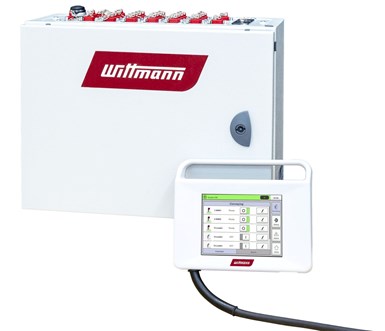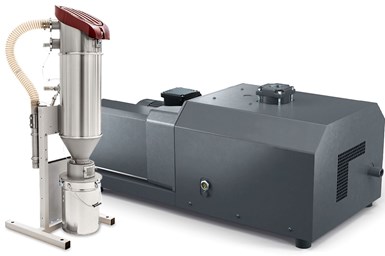Central Controller, Energy-Efficient Pump for Conveying
Wittmann debuts new control system and pump at Fakuma.
Debuting at Fakuma, Wittmann’s E-Max 2 is a compact conveying control system that can be used to implement material conveying with up to 24 conveying points and up to two vacuum circuits.
Wittmann says the central material loaders used can be easily connected to the central conveying control, which enables a material conveying system to be set up quickly and easily. If the requirements increase, the system can be expanded just as easily to include additional material loaders.

The E-Max 2 is operated and visualized via a high-resolution 5.7-inch touch display. Simple settings can be made conveniently via the display. It is also possible to make more extensive entries of different conveying parameters — with the goal of optimizing the processes in the conveying system. The E-Max 2 has a user administration that can be used to define access rights, thus additionally securing the system.
According to Wittmann, the material conveying control represents the optimal solution for small- to medium-sized material conveying applications.
In other news related to conveying, Wittmann introduced the EcoDrive vacuum pump, which automatically optimizes the energy consumption of central material conveying systems to reliably carry all materials to their usage point.
Despite this new and added function, the company says nothing changes about operating the entire system, noting that the optimization steps of the EcoDrive vacuum pump are carried out in the background without the operator having to get involved.
By using appropriate monitoring mechanisms and the associated technology of automatic EcoDrive load control, energy savings of up to 75% can be achieved, depending on the system configuration, according to Wittmann.

The flexible design of the EcoDrive vacuum pump makes it possible to use this new technology in both new and existing systems. This represents another important step in efforts to optimize the energy consumption of plastics production and to reduce energy costs.
Related Content
-
PiovanGroup Rebrands, with Mostly Minor Name Changes
For the most part, subsidiary company names will remain, with slight modifications meant to enhance the Group’s identity.
-
Automated Resin Management and Blending System for Tight Spaces
NPE2024: Designed for new and existing operations with up to 10 machines and limited available space.
-
How to Effectively Reduce Costs with Smart Auxiliaries Technology
As drying, blending and conveying technologies grow more sophisticated, they offer processors great opportunities to reduce cost through better energy efficiency, smaller equipment footprints, reduced scrap and quicker changeovers. Increased throughput and better utilization of primary processing equipment and manpower are the results.




